20 years of the evolution of the Internet in Ukraine, and which network do you remember 20 or 10 years ago?
By writing this publication I was encouraged by the publication on Habré of a rather lengthy article: “Nostalgia post. Secrets of Internet prices: why megabits can cost from $ 0 to $ 200 or how to get 100 Gbit / s for a penny? ” , Which, alas, turned out to be too overloaded due to the volume of the material in question and would be completely incomplete without this section. Especially since I come from Ukraine, I remember and know the topic from my own experience, so I would like to dwell separately on the history of the development of the Internet in our region and share memorable moments.

Moreover, this year marks 20 years since Ukrtelecom received the first foreign channel of huge capacity at that time in Ukraine - 2 Mbit / s to London. Yes, yes, 2 Mbit / s in 1997 to the whole country! And how do you remember the Internet?In the comments to this publication I propose to share your experience, when you first came online and how it was. It is necessary for the formation of a general picture of how much the transfer of data has decreased and what unique opportunities we have with you today in comparison with the era of the emergence of Internet providers. Let's start!
Back in 1988, the first experiments with data transmission on the territory of modern Ukraine were started by Ukrainian scientists, but the first providers appeared only in 1990. At that time, the electronic messaging service was widely spread in the world, and in the USSR one of the leading operators providing this service was "Relcom". In Ukraine, regional centers of access to this network were established at telephone and telegraph stations. Very soon, these sites came under the management of the newly established company “Relcom-Ukraine”, and therefore the Internet of that time was called by many “Relcom”.
Since 1991, a new joint venture, Infocom, was formed, which began building a national scale network based on long-distance analog channels of the Ministry of Communications of Ukraine, and the network has access to international data networks. A little later, thanks to the initiative of enthusiasts, the Internet zone .UA was obtained in 1992, and the Kharkov company Konkom, providing dial-up access between Kharkov and Moscow, acquired a dedicated line in this direction and was the first in Ukraine to switch to the Internet protocol TCP-IP , thus first implementing uninterrupted online access to the Internet network.
In 1994, there were already a few dozen Internet service providers in Ukraine, but the scale of Internet penetration was insignificant until 1999, when the number of subscribers in Kiev reached 10,000, access to the network for which was provided by about 50 providers. All this did not allow them in Ukraine to significantly modernize and expand their networks. However, nevertheless, in the initial period, this activity was not regulated by the state in any way, which allowed for healthy competition, in the absence of expensive licensing, which, however, they tried to introduce repeatedly, but most of the providers continued to operate without a license and the attempts of the authorities were unsuccessful.
At the end of 1994, Infocom invests about $ 3 million to build a national scale network, unites Kiev, Dnepropetrovsk, Lviv and Odessa, while providing Internet access for only 1000+ clients. A little later, Golden Telecom and Farlep are also actively building their own backbone networks between the major cities of Ukraine, which has a significant impact on the cost of their services, which only large companies could afford.
Home users appear the first local area networks in 1994-1996, mainly for the purpose of gaming and file sharing, initially uniting several computers within an apartment building that do not have access to the Internet. After a decade, the most active of them will turn into major Internet service providers providing access for hundreds, thousands and tens of thousands of subscribers at space speeds for the 90s - tens of megabits per second.
It is worth noting that www originates in 1991, along with html and http, however, the first Mosaic browser appeared only in 1993, and www gained popularity perhaps only from 1996, before that the Internet was used mainly for file transfer and e-mail.
The first international fiber-optic communication line (FOCL) was built in 1996 as part of the international project ITUR, it passed through Palermo (Italy), Istanbul (Turkey), Odessa (Ukraine) and ended in Novosibirsk (Russia). The total length of the VOLS was 3500 km, and the cost of the project exceeded $ 150 million. At the same time, the Kiev-Odessa FOCL was 975 km long with branches to Kirovograd, Nikolaev and Cherkasy.
Since 1997, Ukrtelecom has entered the market, opening the first Internet site in Kiev, connected to the UUNET site in London at a speed of 2 Mbit / s via a fiber-optic communication line. Until the beginning of 2000, several more nodes appeared in large cities, but the Ukrtelecom network began to develop massively only in 2000, when the nodes were created in all major regional and district centers and received a connection between them at a speed of 2 Mbit / s.
At the end of 2000, Ukrtelecom began providing Internet access services via Dial-up for home users, and in the summer of 2001, in order to crush competitors, it introduces the pricing of city telephony immediately after the transition from analog telephone to digital lines is completed, which made the service of competitors automatically more expensive . The very same “Ukrtelecom”, after a while, offers Internet access “for free”, in exchange for the city telephone service, about 3.6 UAH / hour ($ 0.72 / hour), thereby changing the rules of the game in the market of dial-up connection .
Gradually, the “callback” service began to gain popularity when, after the connection was established, the modem pool, using the AT command, sent, disconnected the Internet connection and called back the modem that was in standby mode for the connection from the ISP.
I still have several access cards from that period. Who comes from Kiev - has the opportunity to be saddened :)
Providers such as “SvitOnline” (Dial-Up brand “Golden Telecom”):

Lost a huge number of subscribers since the introduction of per-minute pricing of local telephony, including me, because they did not provide Call Back service.
The Call Back service itself became very popular and probably remained in operation until 2011, despite the proliferation of leased lines and broadband Internet access, here are a few cards of that period from Internet providers providing access to Kiev:

A little later, closer to 2003, Optima Telecom , a Dnepropetrovsk provider , entered the market and began to offer freer access to the Internet by offering package tariffs.
So a 10-party card (Internet access from 18 to 23) cost 28 hryvnias ($ 5.6), not to be confused with a 10-night card (Internet access from 18 to 9 am), and a card with unlimited Internet access only Weekends during the month cost around 48 hryvnias ($ 9.6), for the rest of the time access was offered hourly, and access at night was twice as cheap as daytime:
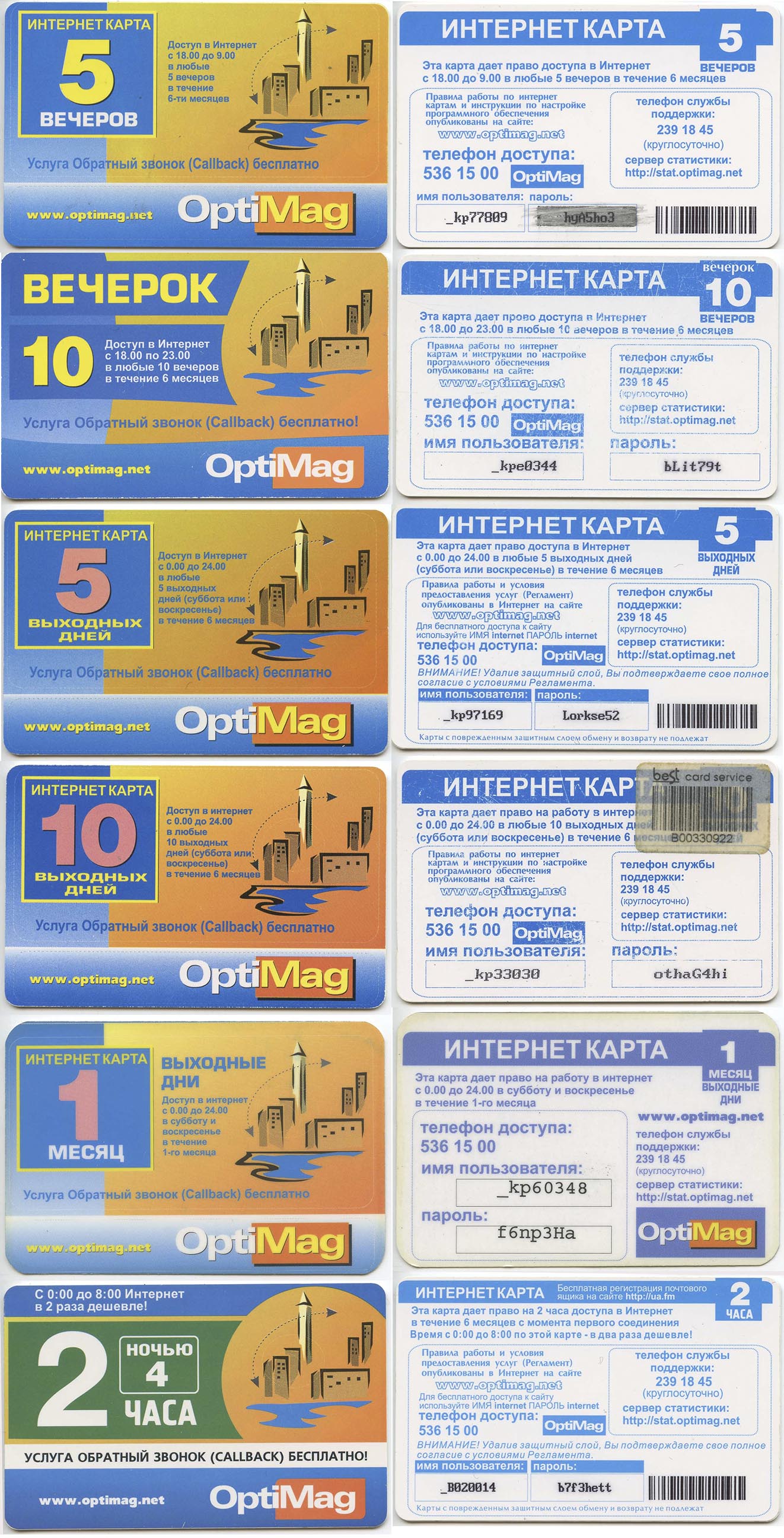
Around 2004, the Odessa provider TeNet began offering unlimited access not only at weekends, but and on weekdays, both in Kiev and Odessa:

It's funny to read reviews of that time :
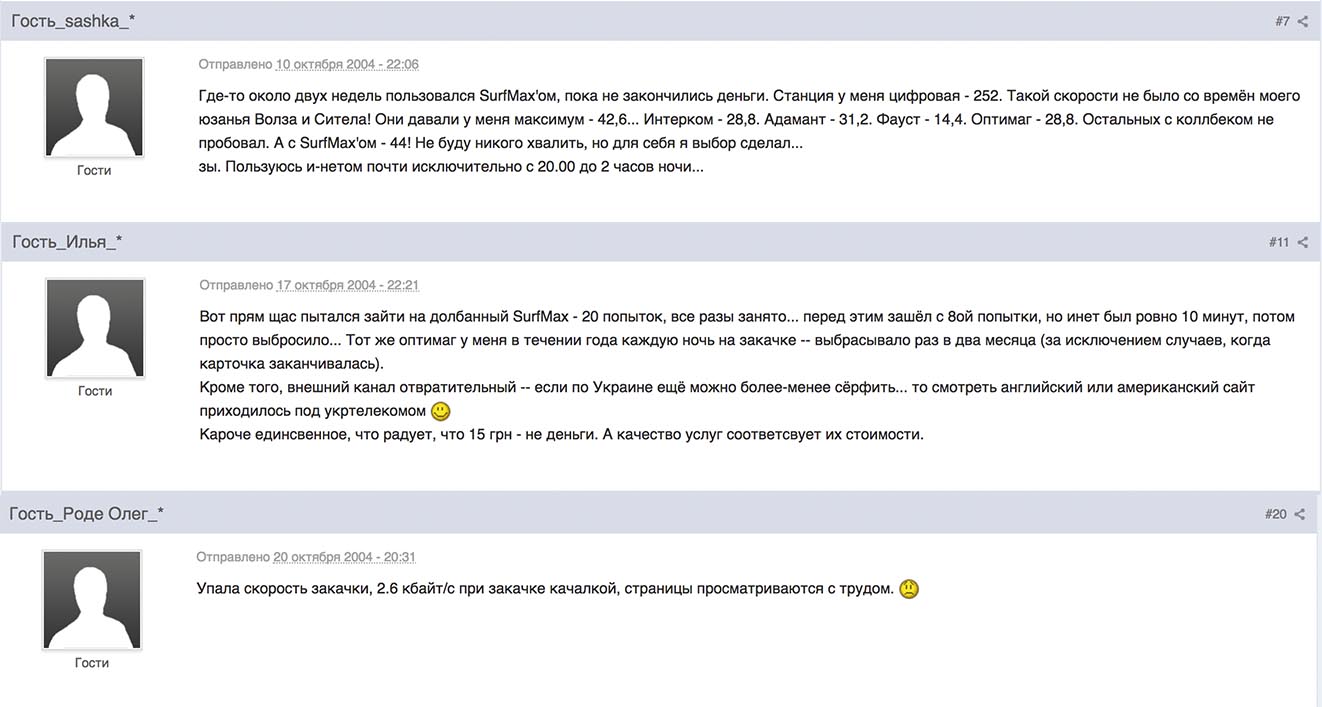
Yes, 5 KB / s speed considered good! Well, “we want to eat a lot” we are now, when we say “badly”, which “shakes” 2 Mbit / s and the video slows down ...
It is because of this situation and unstable communication channels that download managers have gained popularity, which allowed downloading files when the connection was broken, continue or schedule downloads at a convenient time, and even speed up the download by simultaneously downloading the file into several “streams”. Perhaps the most popular of them at that time was Download Master, which was created by the Ukrainian company West Byte in 2002 and was completely free for the countries of the former Soviet Union, and in the foreign segment it is known as Internet Download Accelerator (IDA) and was a paid program (shareware license), which is logical, our people would never pay for software and would find a way to “hack” and save.
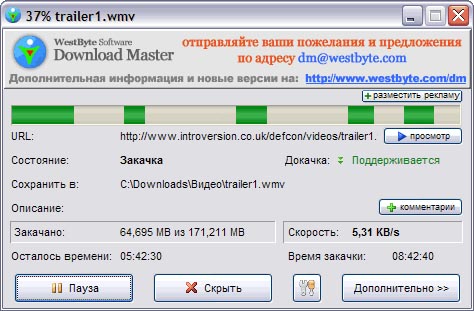
Yes, yes, the speed is exactly 5 Kbytes / s, which corresponds to a modem connection. By the way, due to data compression, TIFF files were pumped out at a speed of 2 Mbps, even using a modem connection, which theoretically could not provide speeds higher than 56 Kbps (7 Kilobytes / s), but I personally observed this speed when downloading using Download Master.
Later Download Master was irreplaceable even when connected via a dedicated line: The
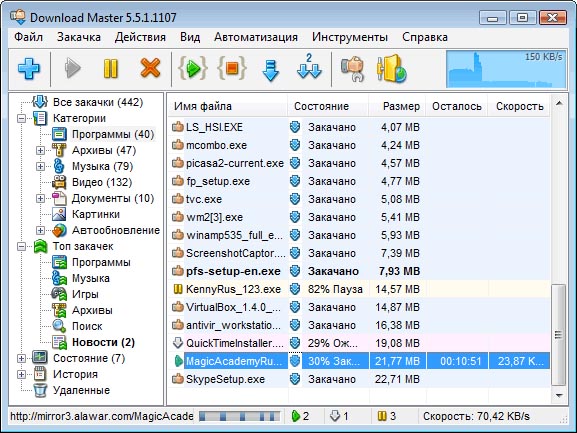
speeds were still not very high, and I wanted to watch movies.
But back to the "Ukrtelecom". In the beginning of 2000, having created a 2 Mbit / s backbone network across the country, Ukrtelecom began to provide connectivity over a “dedicated line” at 64 Kbps and more using two or four wire connections, providing n * 64 digital channels Kbps ( ISDN ) or virtual frame relay channels. In 2001, the capacity of external (foreign) channels of Ukrtelecom becomes equal to 82 Mbit / s, compared to 8 Mbit / s, which accounted for all other Internet operators, making Ukrtelecom the absolute monopolist in the communications market for providing foreign channels. Since August 2002, Ukrtelecom has reduced prices 5 times for subscribers in Kiev and 8 times for regions, the cost of access using xDSL technology (leased line) becomes “very affordable” for subscribers :
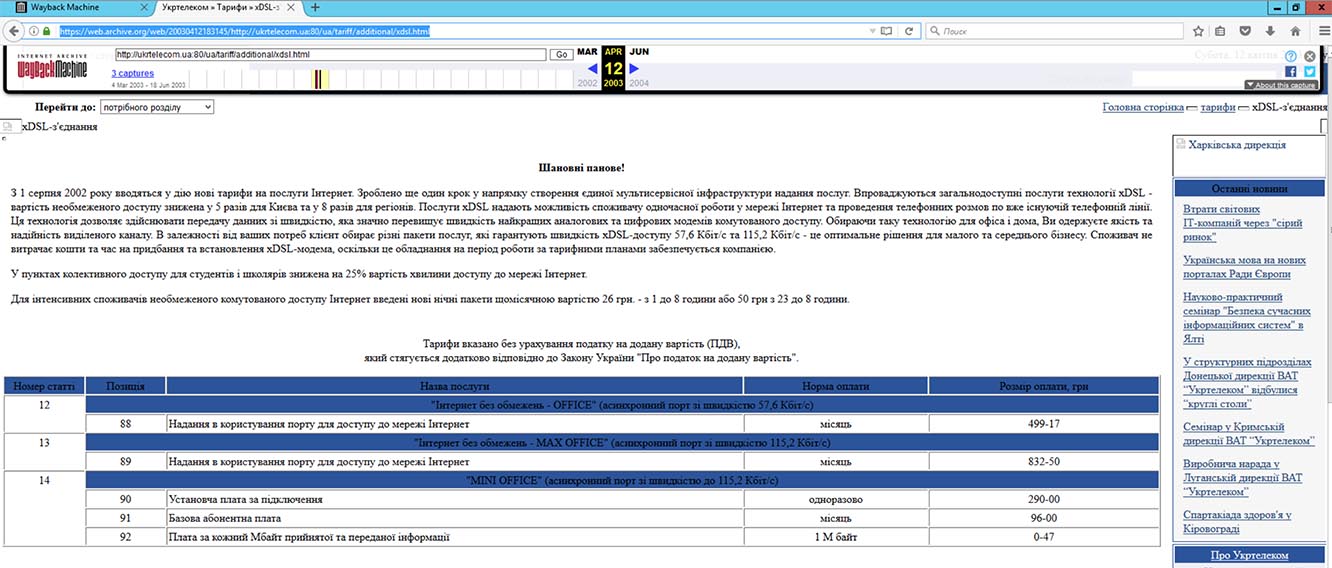
And it amounts to “only” 499.17 UAH / month (about $ 100 / month) for speeds up to 56.7 Kbps without traffic and 832.50 UAH / month ($ 166.5 / month) for access at speed 115, 2 Kbps A more “cheaper” option was offered, with a subscription fee of $ 20 and payment for traffic at a speed of 115.2 Kbps at a price of about $ 0.10 / MB (47 kopecks). It is easy to calculate that for $ 100 it was possible to pump only 1 GB of traffic using this tariff, which completely deprived this type of rating for the majority of subscribers. After all, with a speed of 115.2 Kbps, without taking into account, it was possible to download this month if you put the same download manager, about 115.2 / 8 * 86.4 * 30 = 37,324.8 MB of traffic, valued at $ 3,500 at this rate .
Thus, paying for access to the Internet at a speed of 115.2 Kbps with traffic and megabyte pricing was beneficial only in cases of infrequent use of the Internet, 1-2% of the total time (and downloading such a channel was 100% easy), which was comparable to 8 hours of “surfing” per month at maximum speed. In principle, it is possible and beneficial if you only look at websites and download almost nothing. Since in the case of Dial-Up and time rating, you had to disconnect from the modem pool every time, as soon as all the pages are downloaded and reconnected, if you need to follow the link somewhere, it took a lot of time and was accompanied by similar sounds:
And twice, if you are connected using the “Call Back” service. By the way, the connection “stretched” 7 times sounds interesting:
If you planned not only to surf, but also download data, it was advisable to use “unlimited” time plans, such as access over the weekend from OptiMag and you could download information for 48 hours, and parallel to “surf” in Internet and schedule subsequent downloads. Thus, over the weekend, it was quite realistic to download about 600-700 MB of data and pay $ 2 for it, which was certainly more profitable than access via dedicated lines, where the same amount of traffic could cost 50 or more times more. More precisely, it was more accessible, because not everyone could afford to pay $ 160 / month for Internet access, and not everyone needed 30 GB of traffic and loaded the 115.2K channel at 100% for a month, and Ukrtelecom actually counted on it offering such a tariff without regard to.
In 2002, Ukrtelecom connects regional centers at a speed of 155 Mbit / s, and regional from 2 to 8 Mbit / s, it is planned to increase the number of dial-up subscribers (Dial-Up) to 100,000, in which about $ 15 million was invested It was a real plan, as Ukrtelecom was a monopolist in Ukraine and almost the only provider in the regions. Very rarely, what provider could afford to build its own highway, without having sufficient investments, and Ukrtelecom used it. Selling Internet providers at extremely inflated prices. For example, a 4 Mbps channel without traffic was worth it! 68309 UAH per month ($ 13661 / month)(for comparison, in Europe a similar channel could cost about $ 600 / month), which was incredibly expensive even for Internet providers. Therefore, providers are starting to develop their core networks and external communication channels, although Ukrtelecom strongly discourages this. Later, of course, when the market became saturated, the operator lowered prices, thereby ensuring control over the Internet and wholesale customers, because selling a wide band became much more profitable than dragging the “last mile” to home subscribers. Yes, and providers make a choice in the direction of the channels of Ukrtelecom, as the alternative - satellite Internet, was more expensive and unstable. The increase in the subscriber base allowed providers to start building their own backbone channels over time and Ukrtelecom gradually, especially in large cities, began to lose monopoly.
It is worth noting that the “inadequate” tariffs of Ukrtelecom with a subscription fee of over $ 20,000 / month for 8 Mbit / s without taking into account, could be found on the Ukrtelecom website even in 2005:

No one, of course, at such prices, being in sound mind, did not buy access.
In 2003-2004, an active development of the broadband Internet access market in Kiev took place. TV operator Volia is entering the market, offering Internet access using Docsis 1.0 technology via cable networks at speeds from 64 to 256 Kbps with traffic restrictions:
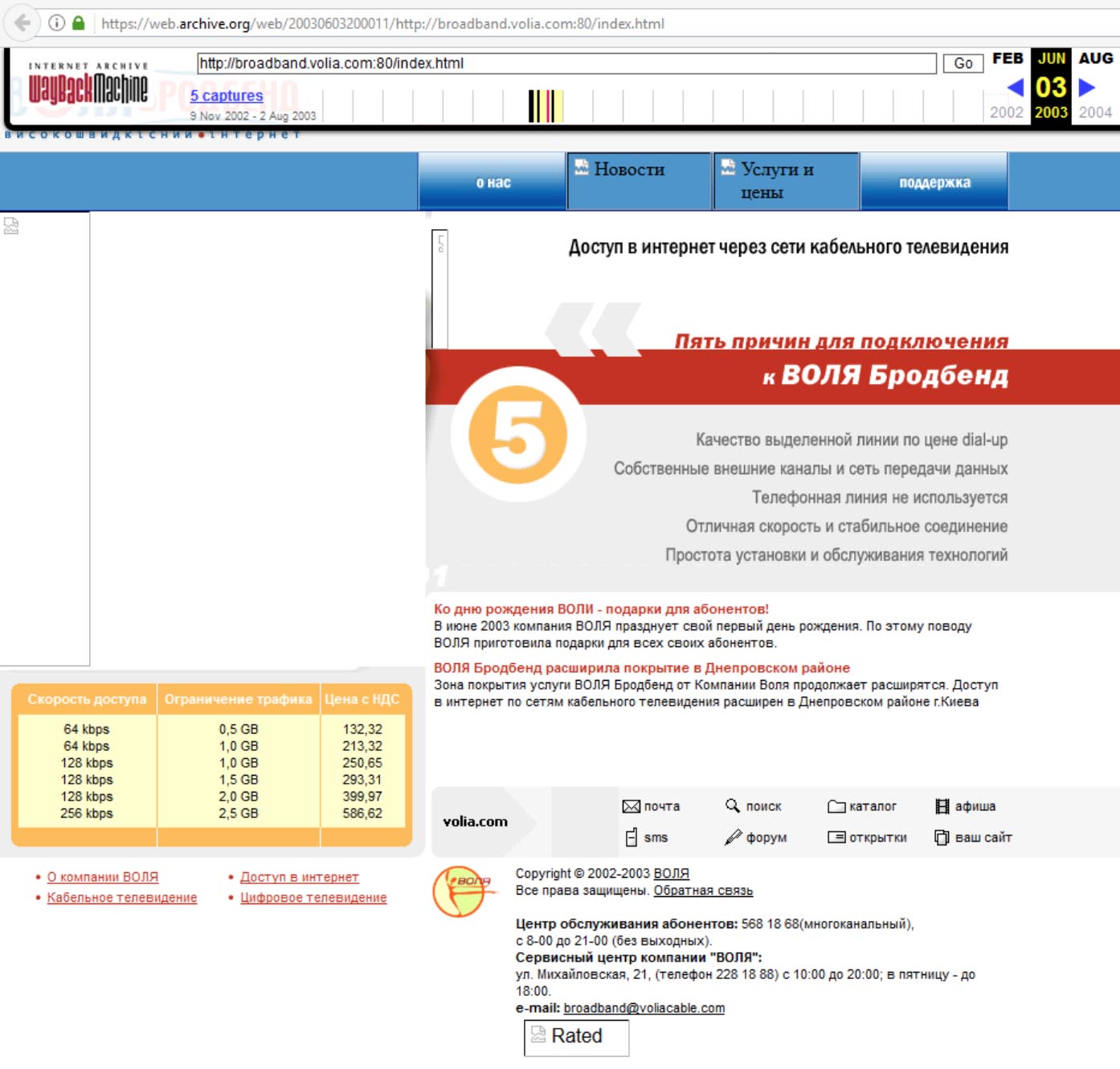
Prices from $ 26 / month for a package with an access speed of 64 Kbps and 500 MB of traffic per month (equivalent to 120 hours of dial-up access, at best, at 100% of the channel) to $ 117 for access at 256 Kbps and 2500 MB traffic per month. That is much better than the offer of "Ukrtelecom" in cases when the channel is not required to load 24/7. However, such access was still very expensive. Therefore, home networks are starting to gain popularity, offering traffic at a lower rate and at a higher speed, due to a batch purchase, for example, at $ 0.11 per MB, without a monthly fee, and at speeds up to 2 Mbps :
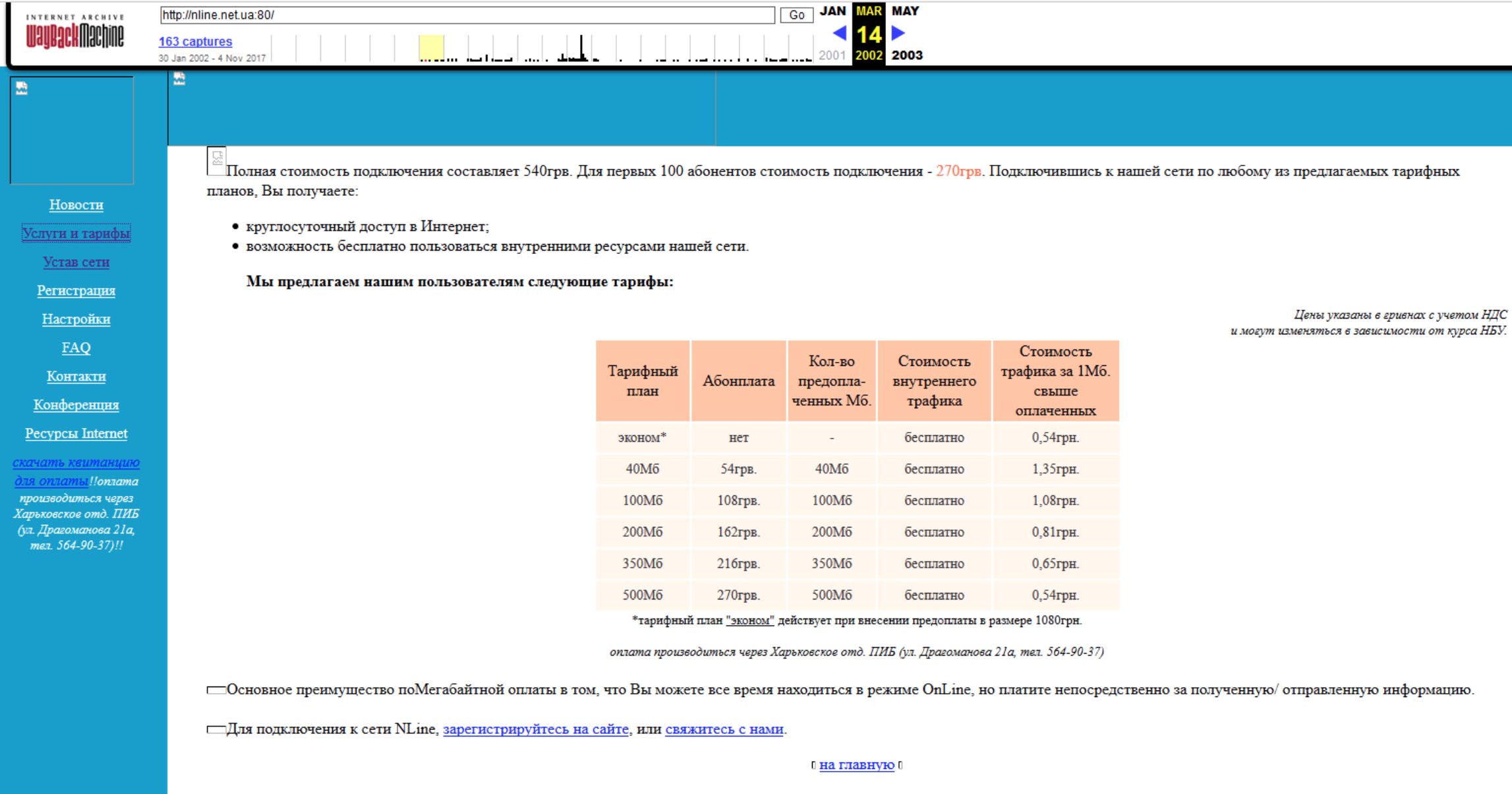
Which of course was very beneficial in the case of web browsing and for possible file sharing between “neighbors”, because the local traffic was free and the speed could reach 10 and even 100 Mbps for the local network, but I never connected to them from - due to the high connection fee (about $ 100) and the need to add another $ 200 to the balance. Later, over a short period of time, they also had a strange “Slow” tariff with 1000 MB of traffic and access speed, like a modem, at 6 Kb / s, while the cost was $ 50 monthly, but by the next update of the tariff plans they removed it and reduced the price of traffic to $ 0.055 / MB. Over time, the number of such home networks has grown, as well as the number of sites
In order to save money on traffic and exchange traffic between subscribers from different networks of Kiev without using expensive foreign channels, UA-IX (Ukrainian traffic exchange point) was created in 2000, the cost of connection to which at a speed of 100 Mbit / s was $ 1000, and a monthly fee of $ 50, a port of 1000 Mbit / s cost $ 3000 one-time and $ 250 monthly, which allowed significant savings. However, there was a difficulty for the new participating providers - it was necessary to get approval from all the current participants and then drag their fiber-optic communication lines to Leontovich 9 (the center of Kiev), where the exchange point was physically located. At that time, the cost of laying 1 km of the fiber optic line was approximately $ 1000 +. It was necessary to pay money for renting the sewage to Ukrtelecom - about $ 10 / km per month. Easy to count that home networks from the Darnitskiy district of the capital should have invested about $ 15,000 in laying their own connection to the center and then paying another $ 250 + 150 monthly for the port in UA-IX at 1000 Mbps and renting the sewage system of Ukrtelecom to which the fiber was laid. Regional providers had to pay even more. Therefore, not every provider from the region could afford to be included in the exchange point directly, and therefore the IP transit service to UA-IX was sometimes in demand. In order to stimulate connection to the exchange point of participants from other cities and even countries, it was decided to exempt them from the monthly fee, nevertheless, this relaxation did not cause a significant influx of people who wanted it - what is a discount of $ 50 or $ 250 monthly, if necessary, investing in laying hundreds of kilometers of fiber and renting poles and / or sewage through which cable runs? Already in 2001, the connection charge was canceled and the conditions were as follows: 100 Mbit / s port at UA-IX ($ 1200 first month of use, next $ 110), 1000 Mbit / s port ($ 3,850 at first, next $ 550). Tariffs were increased, as the need for exchange exceeded the capacity of the equipment and required expansion of the exchange point, and this required additional investments.
In 2003, the cost of connecting and using the UA-IX became even lower - 100 Mbit / s ($ 1,210 the first month, $ 110 the next), an additional 100 Mbit / s ($ 220 the first month, $ 110 the next), 1000 Mbit / s ($ 2,530 the first month, $ 330 next), 100 Mbit / s at regional exchange points ($ 33 the first month, $ 33 next).
All this allowed local networks such as FreeNet and Fasty to start offering access to the UA-IX segment at speeds up to 100 Mbit / s without taking into account traffic for home subscribers and limited access to the foreign segment of the Internet:
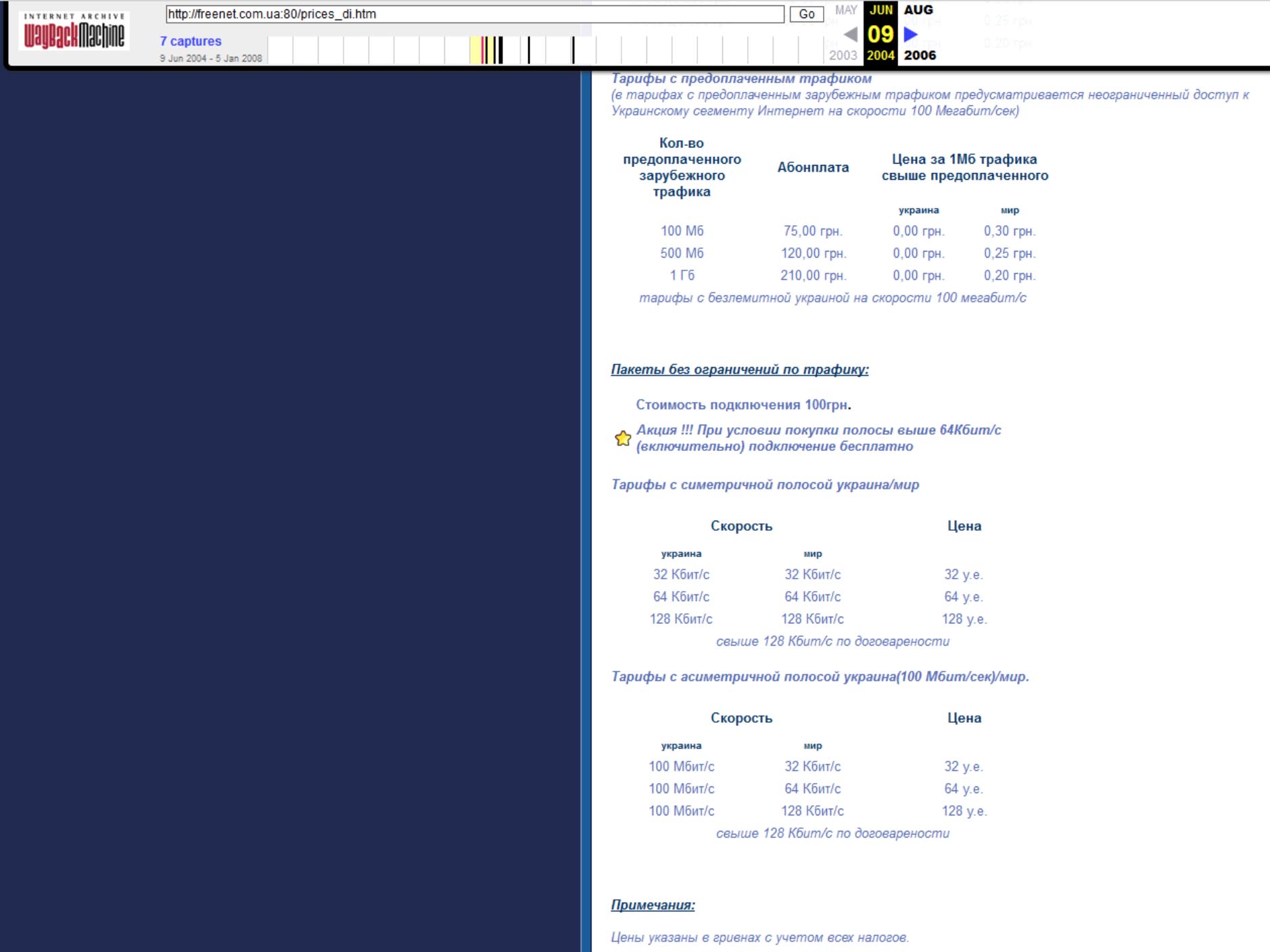
It is interesting that FreeNet offered unlimited foreign at speeds of up to 128 Kbps for $ 128 / month, which is significantly better than the offer of Ukrtelecom.
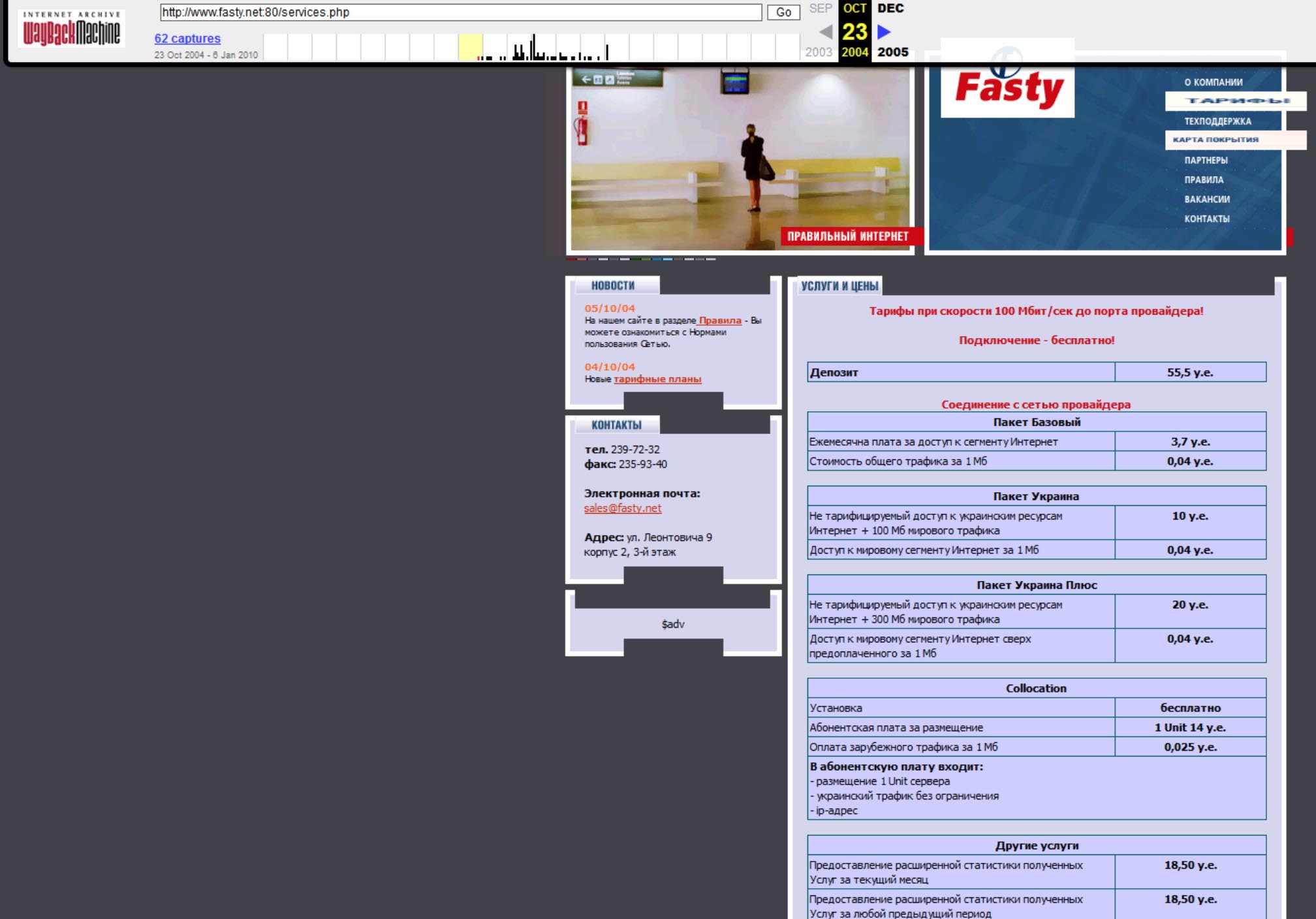
However, it is worth noting that it was not always possible to connect to local networks. Sometimes it was necessary to build a radio channel, which reduced the speed of a possible connection to the local and Ukrainian network to a dozen megabits, or even less. Or be content with a more expensive local man who has already managed to install his equipment and create a monopoly at the expense of an agreement with the house manager on the non-admission of competitors. I had to fight for about six months with the commandant, who stubbornly refused to let Fasty lobbying the interests of expensive Nline, who at that time offered twice as much higher prices for external traffic ($ 0.055 per MB) and the absence of “unlimited” Ukraine and even endured this issue meeting of residents, although by law no one had the right to restrict access to information. In general, after she still survived this provider, He sent a test of Kyivenergo to their switch, which it was impossible to “register” according to the rules of fire safety and connect it to the power grid, because it consumed communal electricity as much as 12 W! But Fasty got out, setting the radio channel to a neighboring, more accommodating house :) Although this led to a decrease in access speed from 100 to 15 Mbit / s, this channel was divided into another 7 subscribers.
Soon, “Volya” makes a retaliatory move and lowers prices :
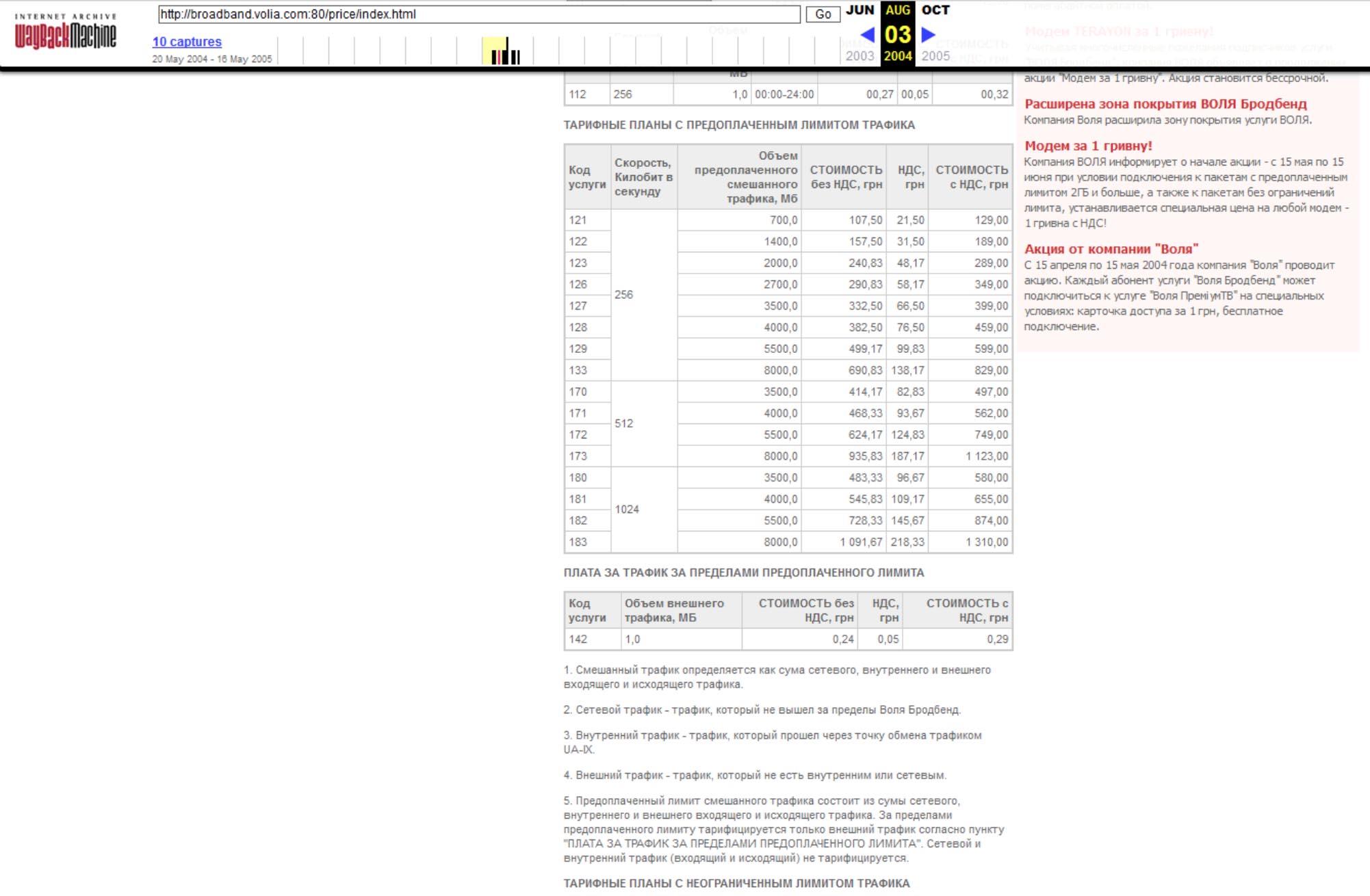
However, “no limit” is still very expensive. 256K costs $ 270 / month, 512K $ 520 / month, 1M - $ 1020 / month. The situation will get better only after 2 months, after the introduction of Docsis 2.0 technology and increasing the speed of Internet access via cable networks to 2 Mbit / sas well as the introduction of a tariff plan for 100 UAH ($ 20) with an access speed of 2 Mbit / s and 500 MB of mixed traffic per month (the sum of domestic, Ukrainian, foreign, incoming and outgoing traffic). However, there was one advantage - the Ukrainian traffic outside the limit was not charged. Thus, pumping out 500 MB of foreign traffic at the beginning of the month, in order not to lose it, you could have unlimited access to UA-IX at 2 Mbit / s and pay $ 0.06 per MB of foreign traffic. That was quite bearable and most of Kiev subscribers began to use such an option, since the cable from Volya was in almost every apartment. Including me, as the house manager again did not let into the house, but already another provider - FreeNet, which could offer 100 Mbit / s to Ukraine for the same money.
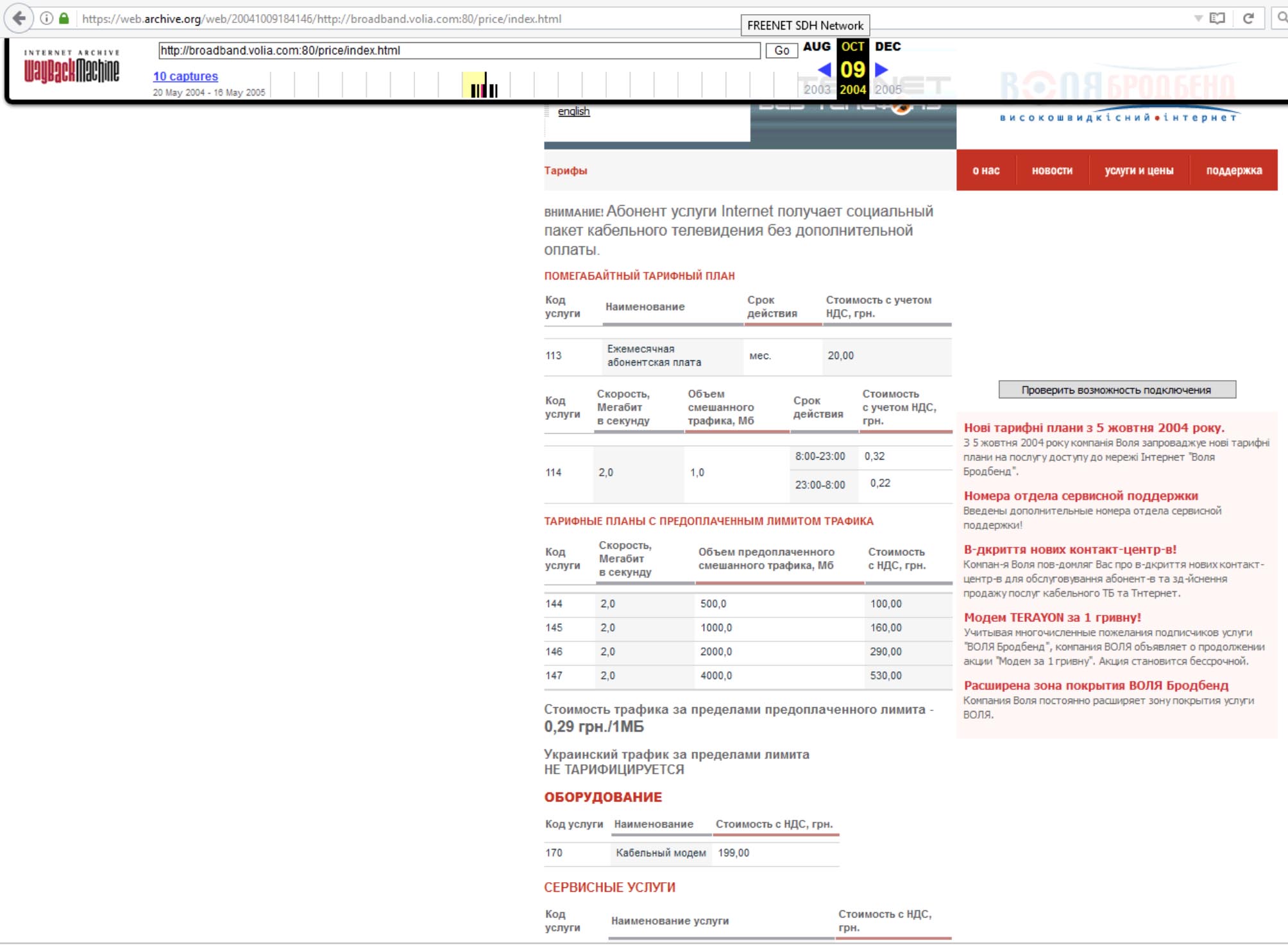
However, from the new year, the company faced overloaded internal networks, when the mass of subscribers exchanged with the help of torrent files and cable stations became overloaded. After all, one CMST had a limited number of modules with a capacity of 38 Mbit / s each and served thousands of subscribers. Unlimited "Ukraine" had to be canceled and since March 2005, tariffs appear with a division into Ukrainian traffic and foreign, with ridiculous limits of Ukrainian traffic (5000 MB instead of unlimited), which caused a storm of indignation among the users of Volya and the threat of a wave of outages due to switching to providers offering Ukraine "unlimited". In order to somehow retain users, we decided to leave the pricing terms unchanged for existing customers for at least March. And in April, for subscribers who do not want to switch to new conditions, they found a way out - reducing the access speed to 256 Kbps, while leaving “no limit”. 2 Mbit / s of "unlimited" is gone, but there was a mass of subscribers, which was withheld by such a decision.
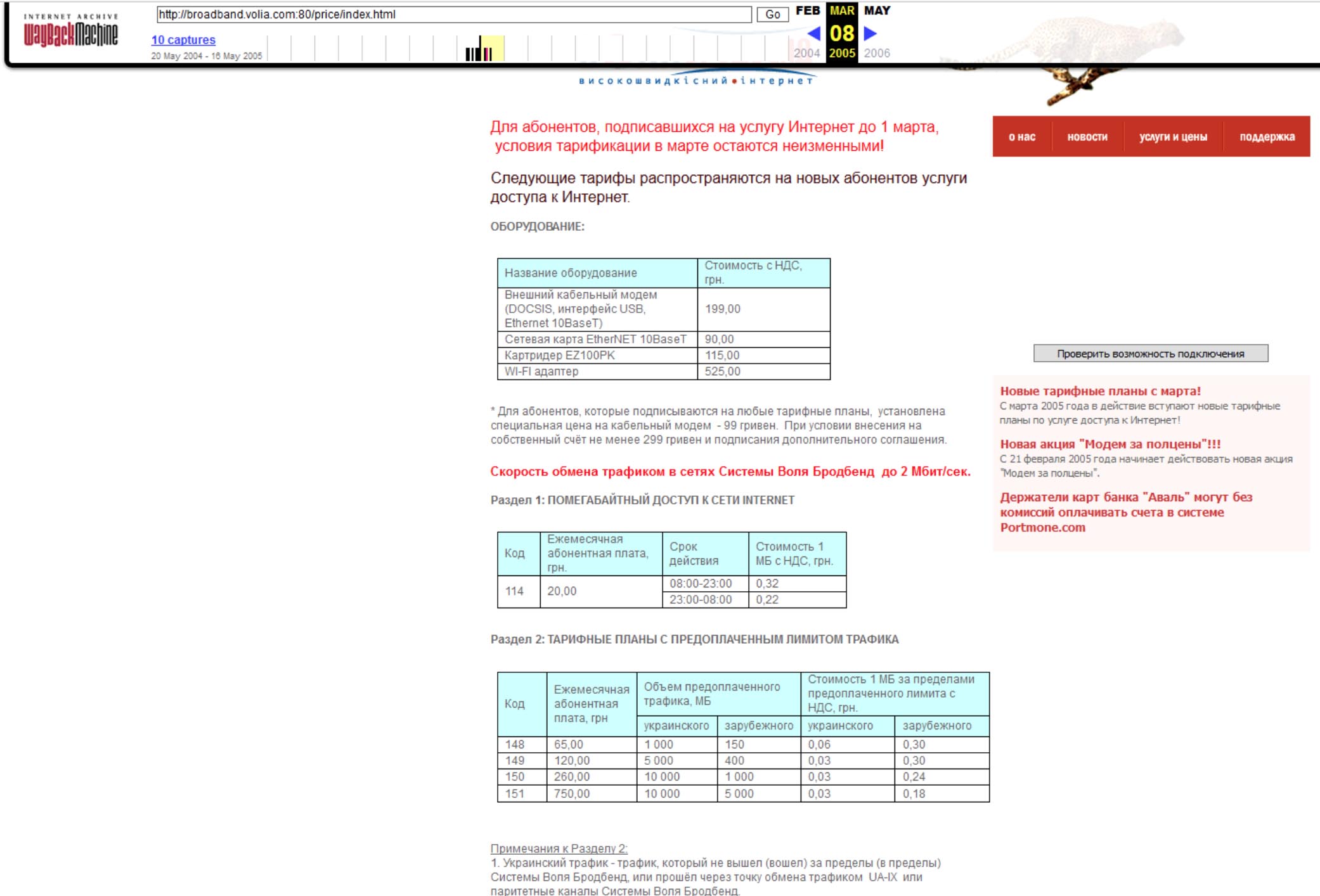
Ukrtelecom, in turn, is starting to offer “nighttime” xDSL unlimited at 115 Kbps for $ 22 / month, charging for day traffic in the amount of $ 0.04 / MB. The main disadvantage of Ukrtelecom is the lack of connection to the Ukrainian traffic exchange point UA-IX, the inability to work with the Ukrainian segment of the Internet at high speeds. In large cities, many have become accustomed to the "unlimited" Ukraine at a speed of 2, 10, and sometimes 100 Mbit / s. However, the scale of Ukrtelecom makes the service still very expensive.
Perhaps I’ll reveal the secret, but at that time Ukrtelecom was able to provide xDSL without accounting for the clock in all regions for 58 UAH / month ($ 11.6), but the management of the retirement age was against this, since significant funds had already been invested in more high-speed ADSL, because Ukrtelecom artificially restrained the demand for this service, since ADSL was offered at high speed at more expensive rates (2.5 GB of traffic for $ 80 at a speed of 512K per download and 128K for sending). Unlimited from Ukrtelecom was offered in this price range (March 2005 prices):
128 kbit / s (reception)
64 kbit / s (transmission) month 1554-58 ($ 310.92)
256 kbit / s (reception)
64 kbit / with (transmission) month 2798-00 ($ 559.60)
512 kbit / s (reception)
128 kbits / s (transmission) month 5000-00 ($ 1000)
Of course, if you had access to an inexpensive channel in UA-IX, these tariffs were meaningless. Since some providers have begun to offer cheap foreign VPNs. One of the same providers was NetAssist, which began its activities back in 2003 with a simple web starcherki with the following information:
Well, the most popular questions of that time:
Overseas traffic using VPNs from NetAssist cost $ 30 per GB in 2003, and in the spring of 2005, the GoodNight night rate was added with the cost of foreign traffic only $ 8.7 per GB, while even local networks offered traffic at a similar speed for $ 25 / GB at best, if you buy immediately from 4 GB per month.

Another important advantage of a VPN was the presence of a static IP address, since not every provider gave a permanent IP, and sometimes took a fee of $ 5 / month for this service. Of course, many providers were dissatisfied with such a service, since NetAssist had no “last mile” costs for a client and only because of this, the price was cheaper, and the providers, offering inexpensive access to “Ukraine”, still wanted to make money abroad traffic. The largest IPNet network that provides Internet access in the Obolon district of the capital introduces a VPN ban, forcing customers to sign an “addendum to the contract”, as well as the torrent were soon banned in order to reduce the load on the Ukrainian channel, which caused quite a big resonance. A similar ban operated in the networks of NLine on the left bank of the capital.
At the end of 2006, the wireless Internet in Ukraine at one of the largest mobile operators, Kyivstar, was perhaps represented by a slow mobile GPRS (analog Dial-Up speed). The cost of WAP traffic that was archaic for other countries at that time was $ 2 per MB over accounting and only about 30 MB of traffic included in the monthly fee was given per month for one of the most expensive tariff plans worth UAH 500 / month ($ 100).
Example of a WAP site of that time:
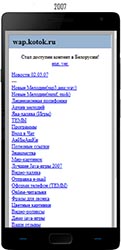
It was awful :)
Standard GPRS traffic was cheaper, but still very expensive - $ 1 / MB over the limit. In 2007, it becomes possible to use the mobile Internet at speeds up to 384 Kbps with the introduction of the "new" technology EDGE. For comparison, in the Russian Federation this technology was introduced at the end of 2004 and the three largest operators - MTS, Beeline, Megafon, began to provide services with the new standard. Tariffs are getting better, and in 2008 Kyivstar offers 1000 MB of traffic per month for imputed money - UAH 200 ($ 25), while from April 2007, 80% of the Ukrainian population were already in the coverage area of the largest EDGE network.
In Kiev in late 2006, the first CDMA operator PeopleNet appears ., which began to provide the Internet under the CDMA 3G standard, as in Ukraine, due to the inability to obtain a license, the standard mobile 3G was simply absent in our time:

The traffic cost is only 10 kopecks per MB ($ 0.02) and the speed is up to 3.6 Mbps (in reality, at the initial stage, just above megabit), the only negative is the coverage. While the service was available only in Kiev, and a little later in the area. The plans were to cover the whole of Ukraine, but it was a long-term perspective - for several years. Soon, Intertelecom, which began work in 2004, also began to provide similar services, making competition to PeopleNet. Prior to that, Intertelecom subscribers could only be content with slow WAP. In 2006, quite seriously, the following was announced on their website :
But after PeopleNet entered the market, Intertelecom began testing its own third-generation 3G CDMA2000 1x EV-DO rel.0 network on Lucent Technologies equipment, ensuring in 2007 it was possible to work at speeds up to 300-500 Kbps with the use of this technology (from 2 Mbit / s as possible) at a cost of $ 0.03 / MB and cheaper. Only in August 2008, the transition to the CDMA2000 1x EV-DO rev.A standard was accomplished, and Intertelecom managed to catch up with a competitor, raising the actual speed to values higher than megabits, and in June 2011, Intertelecom was ahead of PeopleNet and launched the fastest at that time, the wireless network was CDMA2000 1x EV-DO rev.B, where the speed could reach 14.7 Mbit / s, of course, if the base station was not overloaded and you were not too far away.
As for prices, it is worth noting that in 2009 they became more than acceptable and 25 GB of traffic per month cost about $ 35:
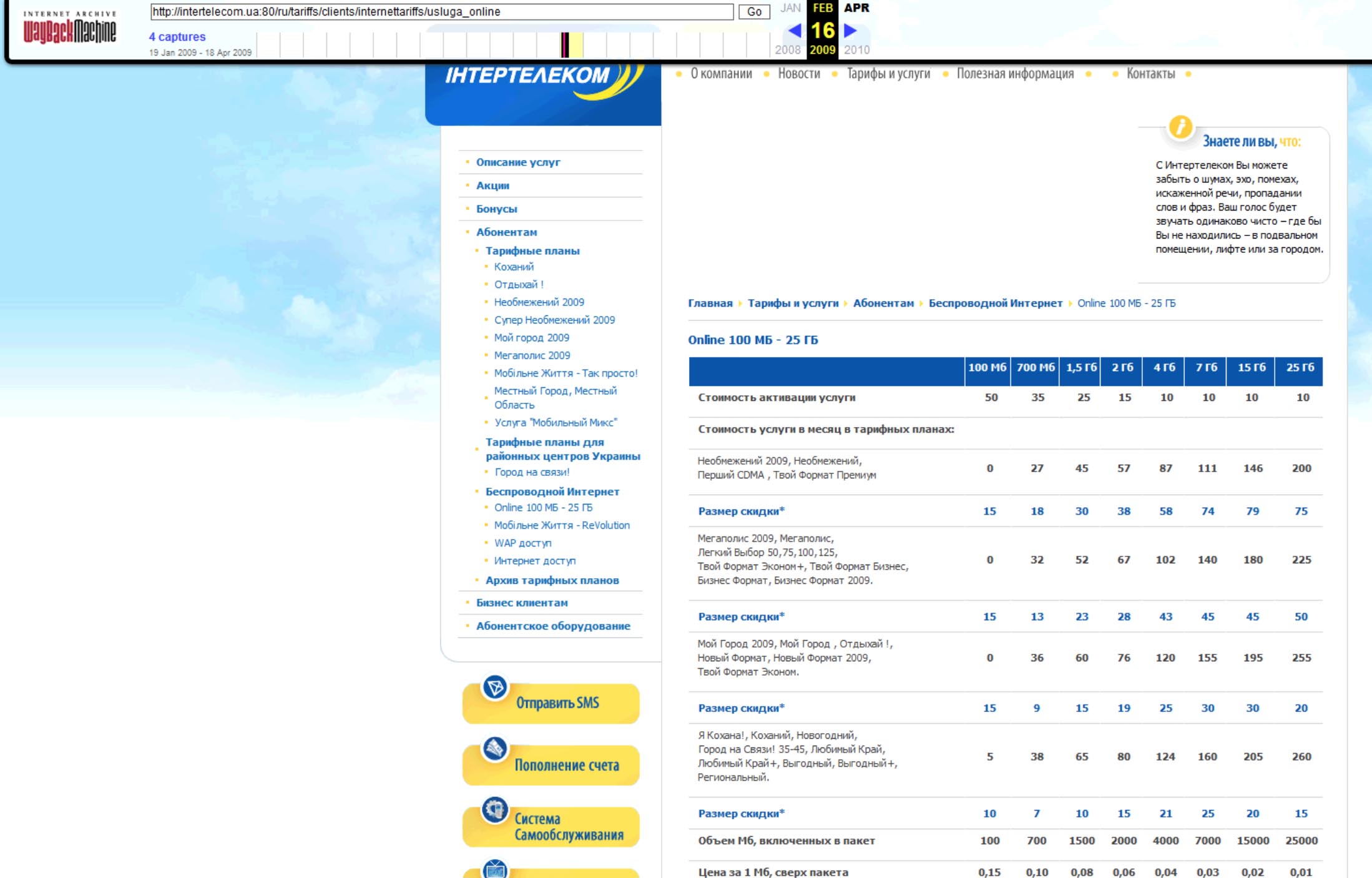
In 2009, the service of wireless access to the Internet of the “fourth” generation was launched, no, not the LTE standard, which we know today, and wimax. The provider “Freshtel” began to connect subscribers at speeds up to 20 Mbit / s with a fixed price of 10 UAH ($ 1.25) per day using the Internet or 180 / UAH a month ($ 22.5).
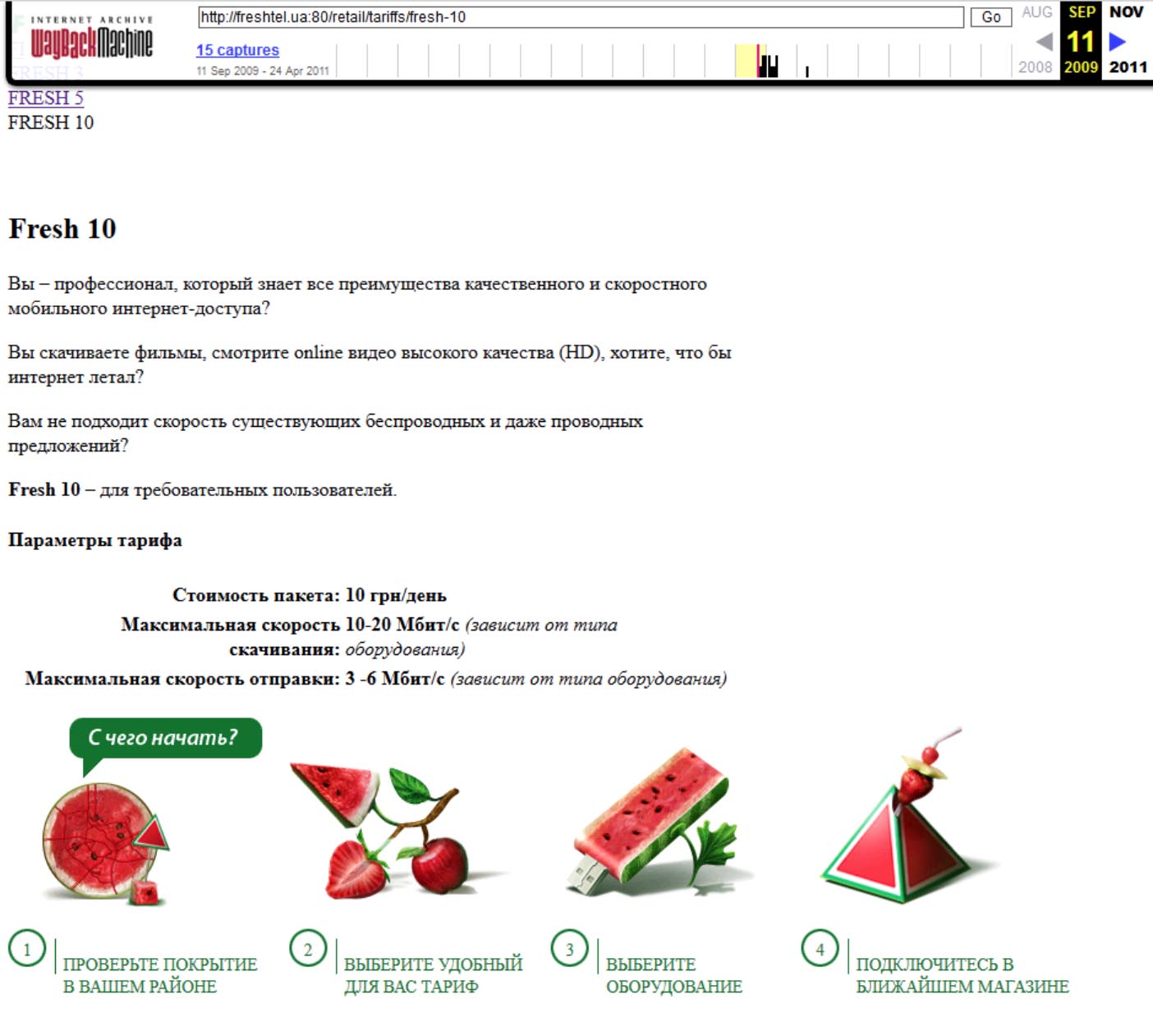
The project, alas, turned out to be not entirely successful, WIMAX was very well absorbed by the iron-concrete structures and did not work well in the premises far from the base stations. In 2011, Intertelecom, having increased the speed of access to its wireless network, also selected a large number of subscribers. And in 2015, when finally the licenses of this 3G were sold to mobile operators:
“Freshtel” lost any appeal, since 3G was much more stable (in some tests the speed was close to 16 Mbit / s, and the average speed was within 7 Mbit / s) and cost less, and most importantly - did not require additional equipment. As a result, the company went bankrupt, and the base stations were disconnected from the grid for non-payment, which caused an uproar in existing customers . However, it is worth noting that “FreshTel” has rescued many subscribers at the time, providing high-speed access where there was simply no other connection.
Following Astelit 3G has been commissioned by other operators:

Which, however, offered a service with much worse rates. It is likely that over time the speed will be higher, and perhaps we still wait for the introduction of LTE. Alas, Ukraine is lagging behind in this regard due to bureaucratic obstacles.
But back in 2005. Ukrtelecom begins to develop ADSL Internet and offers connection speeds of up to 2 Mbit / s in the regions. Of course, all with traffic limits. The maximum tariff of 4 GB is about 286 UAH ($ 57), and at the beginning of 2006 the service was allocated to a separate brand “OGO” , which ceased to exist only in 2014, merging with the main brand of “Ukrtelecom”:
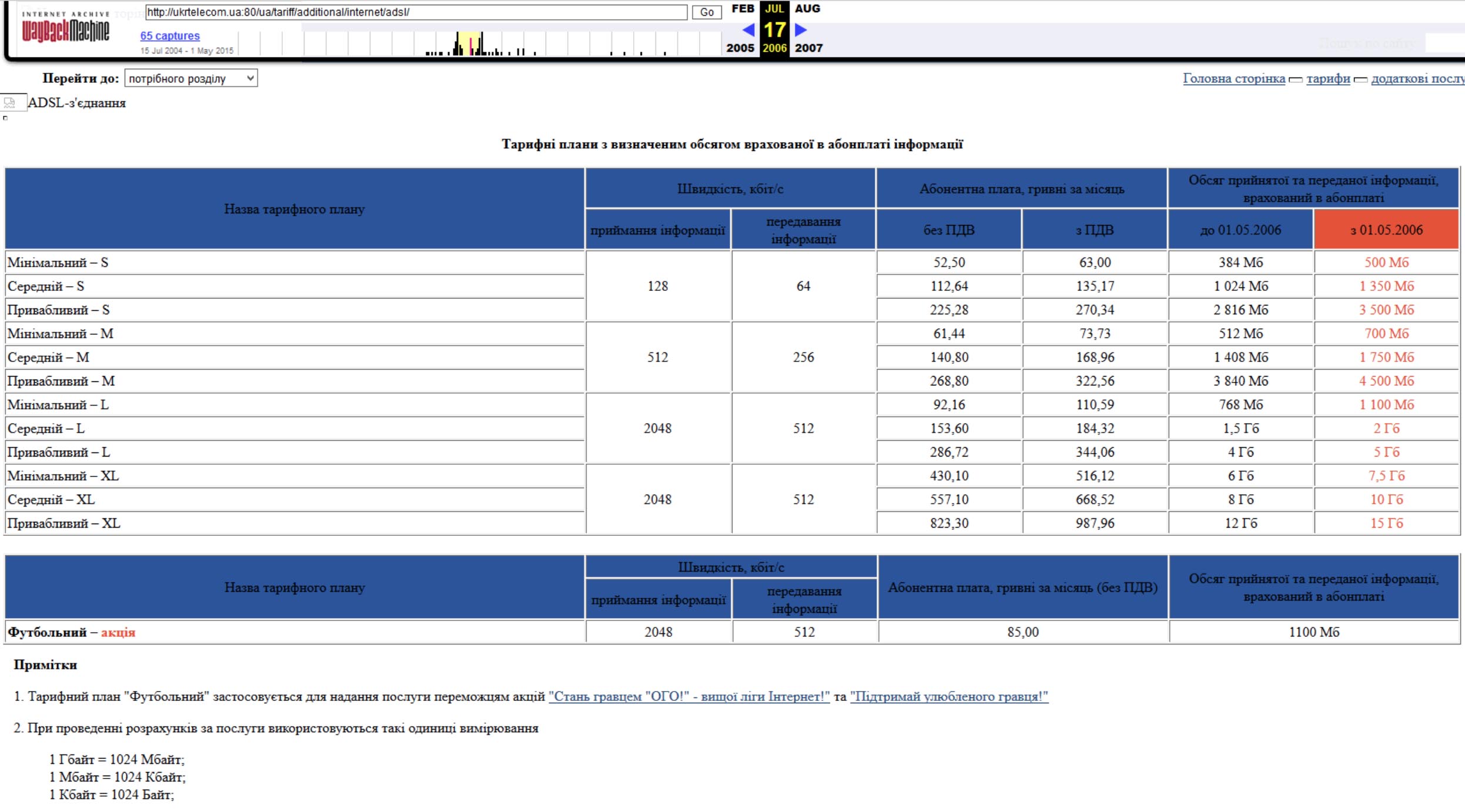
Unlimited cost was still expensive - around $ 360 for 512K and only in 2007 the prices for the Internet without taking into account the traffic became more or less adequate,collapsing to $ 30 per channel 512K / 128K , aided by the policies of competitors.
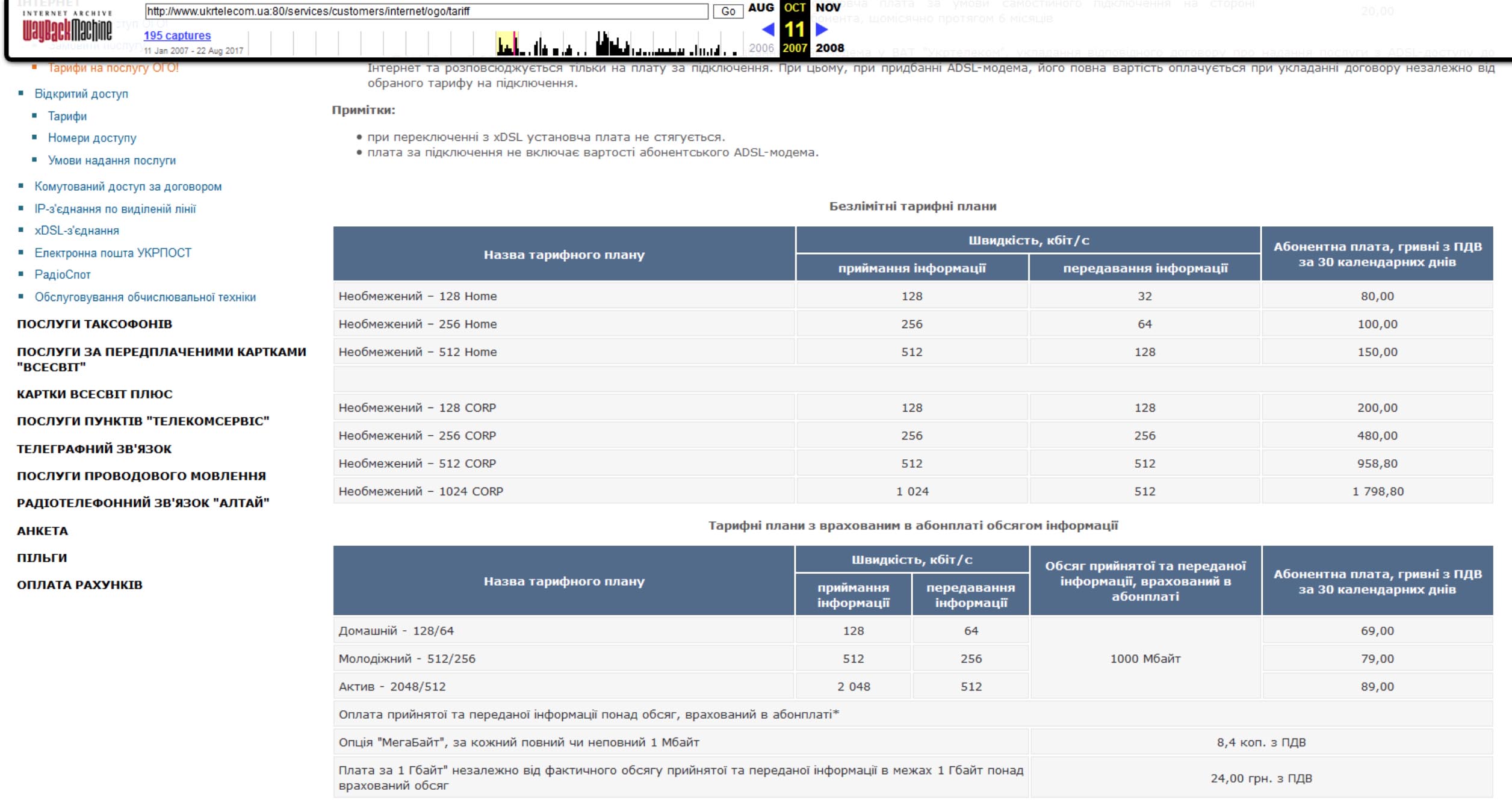
Later, the access speed was increased to 8 Mbps. Few people know that today there are about 14 DSL standards in the world, and one of them is VDSL, capable of providing 300 Mbit / s transmission over a telephone line:

It is interesting that further the DSL standard did not acquire development in Ukraine, since the cable connection and the connection via a dedicated line, including “on optics”, became widespread. Volya begins to develop its presence in another major city, Lviv, and later on in other cities of Ukraine. The spread of the Internet and increasing the speed of access, and hence the availability of information, leads to the rapid development of the IT sector in the field of server hardware and building data centers, thanks to which the web is also developing rapidly, but more on this in the article “Nostalgia Post. Secrets of Internet prices: why megabits can cost from $ 0 to $ 200 or how to get 100 Gbit / s for a penny? " .
BLACK FRIDAY CONTINUES: 30% discount on first payment on promo code BLACK30%when ordering for 1-6 months!
These are not just virtual servers! This is a VPS (KVM) with dedicated drives, which can be no worse than dedicated servers, and in most cases - better! We made VPS (KVM) with dedicated drives in the Netherlands and the USA (configurations from VPS (KVM) - E5-2650v4 (6 Cores) / 10GB DDR4 / 240GB SSD or 4TB HDD / 1Gbps 10TB available at a uniquely low price - from $ 29 / month , options are available with RAID1 and RAID10) , do not miss the chance to place an order for a new type of virtual server, where all resources belong to you, as on a dedicated one, and the price is much lower, with a much more productive hardware!
How to build the infrastructure of the building. class c using servers Dell R730xd E5-2650 v4 worth 9000 euros for a penny?Dell R730xd 2 times cheaper? Only we have 2 x Intel Dodeca-Core Xeon E5-2650v4 128GB DDR4 6x480GB SSD 1Gbps 100 TV from $ 249 in the Netherlands and the USA!

Moreover, this year marks 20 years since Ukrtelecom received the first foreign channel of huge capacity at that time in Ukraine - 2 Mbit / s to London. Yes, yes, 2 Mbit / s in 1997 to the whole country! And how do you remember the Internet?In the comments to this publication I propose to share your experience, when you first came online and how it was. It is necessary for the formation of a general picture of how much the transfer of data has decreased and what unique opportunities we have with you today in comparison with the era of the emergence of Internet providers. Let's start!
Back in 1988, the first experiments with data transmission on the territory of modern Ukraine were started by Ukrainian scientists, but the first providers appeared only in 1990. At that time, the electronic messaging service was widely spread in the world, and in the USSR one of the leading operators providing this service was "Relcom". In Ukraine, regional centers of access to this network were established at telephone and telegraph stations. Very soon, these sites came under the management of the newly established company “Relcom-Ukraine”, and therefore the Internet of that time was called by many “Relcom”.
Since 1991, a new joint venture, Infocom, was formed, which began building a national scale network based on long-distance analog channels of the Ministry of Communications of Ukraine, and the network has access to international data networks. A little later, thanks to the initiative of enthusiasts, the Internet zone .UA was obtained in 1992, and the Kharkov company Konkom, providing dial-up access between Kharkov and Moscow, acquired a dedicated line in this direction and was the first in Ukraine to switch to the Internet protocol TCP-IP , thus first implementing uninterrupted online access to the Internet network.
In 1994, there were already a few dozen Internet service providers in Ukraine, but the scale of Internet penetration was insignificant until 1999, when the number of subscribers in Kiev reached 10,000, access to the network for which was provided by about 50 providers. All this did not allow them in Ukraine to significantly modernize and expand their networks. However, nevertheless, in the initial period, this activity was not regulated by the state in any way, which allowed for healthy competition, in the absence of expensive licensing, which, however, they tried to introduce repeatedly, but most of the providers continued to operate without a license and the attempts of the authorities were unsuccessful.
At the end of 1994, Infocom invests about $ 3 million to build a national scale network, unites Kiev, Dnepropetrovsk, Lviv and Odessa, while providing Internet access for only 1000+ clients. A little later, Golden Telecom and Farlep are also actively building their own backbone networks between the major cities of Ukraine, which has a significant impact on the cost of their services, which only large companies could afford.
Home users appear the first local area networks in 1994-1996, mainly for the purpose of gaming and file sharing, initially uniting several computers within an apartment building that do not have access to the Internet. After a decade, the most active of them will turn into major Internet service providers providing access for hundreds, thousands and tens of thousands of subscribers at space speeds for the 90s - tens of megabits per second.
It is worth noting that www originates in 1991, along with html and http, however, the first Mosaic browser appeared only in 1993, and www gained popularity perhaps only from 1996, before that the Internet was used mainly for file transfer and e-mail.
The first international fiber-optic communication line (FOCL) was built in 1996 as part of the international project ITUR, it passed through Palermo (Italy), Istanbul (Turkey), Odessa (Ukraine) and ended in Novosibirsk (Russia). The total length of the VOLS was 3500 km, and the cost of the project exceeded $ 150 million. At the same time, the Kiev-Odessa FOCL was 975 km long with branches to Kirovograd, Nikolaev and Cherkasy.
Since 1997, Ukrtelecom has entered the market, opening the first Internet site in Kiev, connected to the UUNET site in London at a speed of 2 Mbit / s via a fiber-optic communication line. Until the beginning of 2000, several more nodes appeared in large cities, but the Ukrtelecom network began to develop massively only in 2000, when the nodes were created in all major regional and district centers and received a connection between them at a speed of 2 Mbit / s.
At the end of 2000, Ukrtelecom began providing Internet access services via Dial-up for home users, and in the summer of 2001, in order to crush competitors, it introduces the pricing of city telephony immediately after the transition from analog telephone to digital lines is completed, which made the service of competitors automatically more expensive . The very same “Ukrtelecom”, after a while, offers Internet access “for free”, in exchange for the city telephone service, about 3.6 UAH / hour ($ 0.72 / hour), thereby changing the rules of the game in the market of dial-up connection .
Gradually, the “callback” service began to gain popularity when, after the connection was established, the modem pool, using the AT command, sent, disconnected the Internet connection and called back the modem that was in standby mode for the connection from the ISP.
I still have several access cards from that period. Who comes from Kiev - has the opportunity to be saddened :)
Providers such as “SvitOnline” (Dial-Up brand “Golden Telecom”):

Lost a huge number of subscribers since the introduction of per-minute pricing of local telephony, including me, because they did not provide Call Back service.
The Call Back service itself became very popular and probably remained in operation until 2011, despite the proliferation of leased lines and broadband Internet access, here are a few cards of that period from Internet providers providing access to Kiev:

A little later, closer to 2003, Optima Telecom , a Dnepropetrovsk provider , entered the market and began to offer freer access to the Internet by offering package tariffs.
So a 10-party card (Internet access from 18 to 23) cost 28 hryvnias ($ 5.6), not to be confused with a 10-night card (Internet access from 18 to 9 am), and a card with unlimited Internet access only Weekends during the month cost around 48 hryvnias ($ 9.6), for the rest of the time access was offered hourly, and access at night was twice as cheap as daytime:

Around 2004, the Odessa provider TeNet began offering unlimited access not only at weekends, but and on weekdays, both in Kiev and Odessa:

It's funny to read reviews of that time :

Yes, 5 KB / s speed considered good! Well, “we want to eat a lot” we are now, when we say “badly”, which “shakes” 2 Mbit / s and the video slows down ...
It is because of this situation and unstable communication channels that download managers have gained popularity, which allowed downloading files when the connection was broken, continue or schedule downloads at a convenient time, and even speed up the download by simultaneously downloading the file into several “streams”. Perhaps the most popular of them at that time was Download Master, which was created by the Ukrainian company West Byte in 2002 and was completely free for the countries of the former Soviet Union, and in the foreign segment it is known as Internet Download Accelerator (IDA) and was a paid program (shareware license), which is logical, our people would never pay for software and would find a way to “hack” and save.

Yes, yes, the speed is exactly 5 Kbytes / s, which corresponds to a modem connection. By the way, due to data compression, TIFF files were pumped out at a speed of 2 Mbps, even using a modem connection, which theoretically could not provide speeds higher than 56 Kbps (7 Kilobytes / s), but I personally observed this speed when downloading using Download Master.
Later Download Master was irreplaceable even when connected via a dedicated line: The

speeds were still not very high, and I wanted to watch movies.
But back to the "Ukrtelecom". In the beginning of 2000, having created a 2 Mbit / s backbone network across the country, Ukrtelecom began to provide connectivity over a “dedicated line” at 64 Kbps and more using two or four wire connections, providing n * 64 digital channels Kbps ( ISDN ) or virtual frame relay channels. In 2001, the capacity of external (foreign) channels of Ukrtelecom becomes equal to 82 Mbit / s, compared to 8 Mbit / s, which accounted for all other Internet operators, making Ukrtelecom the absolute monopolist in the communications market for providing foreign channels. Since August 2002, Ukrtelecom has reduced prices 5 times for subscribers in Kiev and 8 times for regions, the cost of access using xDSL technology (leased line) becomes “very affordable” for subscribers :

And it amounts to “only” 499.17 UAH / month (about $ 100 / month) for speeds up to 56.7 Kbps without traffic and 832.50 UAH / month ($ 166.5 / month) for access at speed 115, 2 Kbps A more “cheaper” option was offered, with a subscription fee of $ 20 and payment for traffic at a speed of 115.2 Kbps at a price of about $ 0.10 / MB (47 kopecks). It is easy to calculate that for $ 100 it was possible to pump only 1 GB of traffic using this tariff, which completely deprived this type of rating for the majority of subscribers. After all, with a speed of 115.2 Kbps, without taking into account, it was possible to download this month if you put the same download manager, about 115.2 / 8 * 86.4 * 30 = 37,324.8 MB of traffic, valued at $ 3,500 at this rate .
Thus, paying for access to the Internet at a speed of 115.2 Kbps with traffic and megabyte pricing was beneficial only in cases of infrequent use of the Internet, 1-2% of the total time (and downloading such a channel was 100% easy), which was comparable to 8 hours of “surfing” per month at maximum speed. In principle, it is possible and beneficial if you only look at websites and download almost nothing. Since in the case of Dial-Up and time rating, you had to disconnect from the modem pool every time, as soon as all the pages are downloaded and reconnected, if you need to follow the link somewhere, it took a lot of time and was accompanied by similar sounds:
And twice, if you are connected using the “Call Back” service. By the way, the connection “stretched” 7 times sounds interesting:
If you planned not only to surf, but also download data, it was advisable to use “unlimited” time plans, such as access over the weekend from OptiMag and you could download information for 48 hours, and parallel to “surf” in Internet and schedule subsequent downloads. Thus, over the weekend, it was quite realistic to download about 600-700 MB of data and pay $ 2 for it, which was certainly more profitable than access via dedicated lines, where the same amount of traffic could cost 50 or more times more. More precisely, it was more accessible, because not everyone could afford to pay $ 160 / month for Internet access, and not everyone needed 30 GB of traffic and loaded the 115.2K channel at 100% for a month, and Ukrtelecom actually counted on it offering such a tariff without regard to.
In 2002, Ukrtelecom connects regional centers at a speed of 155 Mbit / s, and regional from 2 to 8 Mbit / s, it is planned to increase the number of dial-up subscribers (Dial-Up) to 100,000, in which about $ 15 million was invested It was a real plan, as Ukrtelecom was a monopolist in Ukraine and almost the only provider in the regions. Very rarely, what provider could afford to build its own highway, without having sufficient investments, and Ukrtelecom used it. Selling Internet providers at extremely inflated prices. For example, a 4 Mbps channel without traffic was worth it! 68309 UAH per month ($ 13661 / month)(for comparison, in Europe a similar channel could cost about $ 600 / month), which was incredibly expensive even for Internet providers. Therefore, providers are starting to develop their core networks and external communication channels, although Ukrtelecom strongly discourages this. Later, of course, when the market became saturated, the operator lowered prices, thereby ensuring control over the Internet and wholesale customers, because selling a wide band became much more profitable than dragging the “last mile” to home subscribers. Yes, and providers make a choice in the direction of the channels of Ukrtelecom, as the alternative - satellite Internet, was more expensive and unstable. The increase in the subscriber base allowed providers to start building their own backbone channels over time and Ukrtelecom gradually, especially in large cities, began to lose monopoly.
It is worth noting that the “inadequate” tariffs of Ukrtelecom with a subscription fee of over $ 20,000 / month for 8 Mbit / s without taking into account, could be found on the Ukrtelecom website even in 2005:

No one, of course, at such prices, being in sound mind, did not buy access.
In 2003-2004, an active development of the broadband Internet access market in Kiev took place. TV operator Volia is entering the market, offering Internet access using Docsis 1.0 technology via cable networks at speeds from 64 to 256 Kbps with traffic restrictions:

Prices from $ 26 / month for a package with an access speed of 64 Kbps and 500 MB of traffic per month (equivalent to 120 hours of dial-up access, at best, at 100% of the channel) to $ 117 for access at 256 Kbps and 2500 MB traffic per month. That is much better than the offer of "Ukrtelecom" in cases when the channel is not required to load 24/7. However, such access was still very expensive. Therefore, home networks are starting to gain popularity, offering traffic at a lower rate and at a higher speed, due to a batch purchase, for example, at $ 0.11 per MB, without a monthly fee, and at speeds up to 2 Mbps :

Which of course was very beneficial in the case of web browsing and for possible file sharing between “neighbors”, because the local traffic was free and the speed could reach 10 and even 100 Mbps for the local network, but I never connected to them from - due to the high connection fee (about $ 100) and the need to add another $ 200 to the balance. Later, over a short period of time, they also had a strange “Slow” tariff with 1000 MB of traffic and access speed, like a modem, at 6 Kb / s, while the cost was $ 50 monthly, but by the next update of the tariff plans they removed it and reduced the price of traffic to $ 0.055 / MB. Over time, the number of such home networks has grown, as well as the number of sites
In order to save money on traffic and exchange traffic between subscribers from different networks of Kiev without using expensive foreign channels, UA-IX (Ukrainian traffic exchange point) was created in 2000, the cost of connection to which at a speed of 100 Mbit / s was $ 1000, and a monthly fee of $ 50, a port of 1000 Mbit / s cost $ 3000 one-time and $ 250 monthly, which allowed significant savings. However, there was a difficulty for the new participating providers - it was necessary to get approval from all the current participants and then drag their fiber-optic communication lines to Leontovich 9 (the center of Kiev), where the exchange point was physically located. At that time, the cost of laying 1 km of the fiber optic line was approximately $ 1000 +. It was necessary to pay money for renting the sewage to Ukrtelecom - about $ 10 / km per month. Easy to count that home networks from the Darnitskiy district of the capital should have invested about $ 15,000 in laying their own connection to the center and then paying another $ 250 + 150 monthly for the port in UA-IX at 1000 Mbps and renting the sewage system of Ukrtelecom to which the fiber was laid. Regional providers had to pay even more. Therefore, not every provider from the region could afford to be included in the exchange point directly, and therefore the IP transit service to UA-IX was sometimes in demand. In order to stimulate connection to the exchange point of participants from other cities and even countries, it was decided to exempt them from the monthly fee, nevertheless, this relaxation did not cause a significant influx of people who wanted it - what is a discount of $ 50 or $ 250 monthly, if necessary, investing in laying hundreds of kilometers of fiber and renting poles and / or sewage through which cable runs? Already in 2001, the connection charge was canceled and the conditions were as follows: 100 Mbit / s port at UA-IX ($ 1200 first month of use, next $ 110), 1000 Mbit / s port ($ 3,850 at first, next $ 550). Tariffs were increased, as the need for exchange exceeded the capacity of the equipment and required expansion of the exchange point, and this required additional investments.
In 2003, the cost of connecting and using the UA-IX became even lower - 100 Mbit / s ($ 1,210 the first month, $ 110 the next), an additional 100 Mbit / s ($ 220 the first month, $ 110 the next), 1000 Mbit / s ($ 2,530 the first month, $ 330 next), 100 Mbit / s at regional exchange points ($ 33 the first month, $ 33 next).
All this allowed local networks such as FreeNet and Fasty to start offering access to the UA-IX segment at speeds up to 100 Mbit / s without taking into account traffic for home subscribers and limited access to the foreign segment of the Internet:

It is interesting that FreeNet offered unlimited foreign at speeds of up to 128 Kbps for $ 128 / month, which is significantly better than the offer of Ukrtelecom.

However, it is worth noting that it was not always possible to connect to local networks. Sometimes it was necessary to build a radio channel, which reduced the speed of a possible connection to the local and Ukrainian network to a dozen megabits, or even less. Or be content with a more expensive local man who has already managed to install his equipment and create a monopoly at the expense of an agreement with the house manager on the non-admission of competitors. I had to fight for about six months with the commandant, who stubbornly refused to let Fasty lobbying the interests of expensive Nline, who at that time offered twice as much higher prices for external traffic ($ 0.055 per MB) and the absence of “unlimited” Ukraine and even endured this issue meeting of residents, although by law no one had the right to restrict access to information. In general, after she still survived this provider, He sent a test of Kyivenergo to their switch, which it was impossible to “register” according to the rules of fire safety and connect it to the power grid, because it consumed communal electricity as much as 12 W! But Fasty got out, setting the radio channel to a neighboring, more accommodating house :) Although this led to a decrease in access speed from 100 to 15 Mbit / s, this channel was divided into another 7 subscribers.
Soon, “Volya” makes a retaliatory move and lowers prices :

However, “no limit” is still very expensive. 256K costs $ 270 / month, 512K $ 520 / month, 1M - $ 1020 / month. The situation will get better only after 2 months, after the introduction of Docsis 2.0 technology and increasing the speed of Internet access via cable networks to 2 Mbit / sas well as the introduction of a tariff plan for 100 UAH ($ 20) with an access speed of 2 Mbit / s and 500 MB of mixed traffic per month (the sum of domestic, Ukrainian, foreign, incoming and outgoing traffic). However, there was one advantage - the Ukrainian traffic outside the limit was not charged. Thus, pumping out 500 MB of foreign traffic at the beginning of the month, in order not to lose it, you could have unlimited access to UA-IX at 2 Mbit / s and pay $ 0.06 per MB of foreign traffic. That was quite bearable and most of Kiev subscribers began to use such an option, since the cable from Volya was in almost every apartment. Including me, as the house manager again did not let into the house, but already another provider - FreeNet, which could offer 100 Mbit / s to Ukraine for the same money.

However, from the new year, the company faced overloaded internal networks, when the mass of subscribers exchanged with the help of torrent files and cable stations became overloaded. After all, one CMST had a limited number of modules with a capacity of 38 Mbit / s each and served thousands of subscribers. Unlimited "Ukraine" had to be canceled and since March 2005, tariffs appear with a division into Ukrainian traffic and foreign, with ridiculous limits of Ukrainian traffic (5000 MB instead of unlimited), which caused a storm of indignation among the users of Volya and the threat of a wave of outages due to switching to providers offering Ukraine "unlimited". In order to somehow retain users, we decided to leave the pricing terms unchanged for existing customers for at least March. And in April, for subscribers who do not want to switch to new conditions, they found a way out - reducing the access speed to 256 Kbps, while leaving “no limit”. 2 Mbit / s of "unlimited" is gone, but there was a mass of subscribers, which was withheld by such a decision.

Ukrtelecom, in turn, is starting to offer “nighttime” xDSL unlimited at 115 Kbps for $ 22 / month, charging for day traffic in the amount of $ 0.04 / MB. The main disadvantage of Ukrtelecom is the lack of connection to the Ukrainian traffic exchange point UA-IX, the inability to work with the Ukrainian segment of the Internet at high speeds. In large cities, many have become accustomed to the "unlimited" Ukraine at a speed of 2, 10, and sometimes 100 Mbit / s. However, the scale of Ukrtelecom makes the service still very expensive.
Perhaps I’ll reveal the secret, but at that time Ukrtelecom was able to provide xDSL without accounting for the clock in all regions for 58 UAH / month ($ 11.6), but the management of the retirement age was against this, since significant funds had already been invested in more high-speed ADSL, because Ukrtelecom artificially restrained the demand for this service, since ADSL was offered at high speed at more expensive rates (2.5 GB of traffic for $ 80 at a speed of 512K per download and 128K for sending). Unlimited from Ukrtelecom was offered in this price range (March 2005 prices):
128 kbit / s (reception)
64 kbit / s (transmission) month 1554-58 ($ 310.92)
256 kbit / s (reception)
64 kbit / with (transmission) month 2798-00 ($ 559.60)
512 kbit / s (reception)
128 kbits / s (transmission) month 5000-00 ($ 1000)
Of course, if you had access to an inexpensive channel in UA-IX, these tariffs were meaningless. Since some providers have begun to offer cheap foreign VPNs. One of the same providers was NetAssist, which began its activities back in 2003 with a simple web starcherki with the following information:
We offer you a completely new, unique Internet access ... via the Internet! Like this? And very easy! If you do not want your provider to know what you are doing on the web, you want to make it difficult to intercept your email and analyze your traffic, as well as if you have free access to Ukrainian resources and the price of external traffic does not suit you - you come to ! Using the existing connection, we, through our server in Kiev, give you our network details for working with the outside world through the “tunnel” to us from your provider.
Well, the most popular questions of that time:
Why is access through you cheaper if I pay my provider only for the outside world? Because now you will not pay for the outside world to your provider: the traffic for it will be only internal Ukrainian (free), to our server.
And what do you think is free intra-Ukrainian traffic? Traffic to networks (from networks) that have country: UA status in the RIPE database. You can take a list of them, for example, here: www.merezha.net/ua By the way, Ukrtelecom’s networks are considered Ukrainian in our country.
If I have speed sharing, say, 64kbps to the outside world and 2Mbits to Ukrainian resources ... Now you will work with the outside world for 2Mbits.
So, I'm cheating on my provider ...Not. You honestly pay him a monthly fee (including access to internal Ukrainian resources) - only now you buy this service from him.
Overseas traffic using VPNs from NetAssist cost $ 30 per GB in 2003, and in the spring of 2005, the GoodNight night rate was added with the cost of foreign traffic only $ 8.7 per GB, while even local networks offered traffic at a similar speed for $ 25 / GB at best, if you buy immediately from 4 GB per month.

Another important advantage of a VPN was the presence of a static IP address, since not every provider gave a permanent IP, and sometimes took a fee of $ 5 / month for this service. Of course, many providers were dissatisfied with such a service, since NetAssist had no “last mile” costs for a client and only because of this, the price was cheaper, and the providers, offering inexpensive access to “Ukraine”, still wanted to make money abroad traffic. The largest IPNet network that provides Internet access in the Obolon district of the capital introduces a VPN ban, forcing customers to sign an “addendum to the contract”, as well as the torrent were soon banned in order to reduce the load on the Ukrainian channel, which caused quite a big resonance. A similar ban operated in the networks of NLine on the left bank of the capital.
What about wireless internet?
At the end of 2006, the wireless Internet in Ukraine at one of the largest mobile operators, Kyivstar, was perhaps represented by a slow mobile GPRS (analog Dial-Up speed). The cost of WAP traffic that was archaic for other countries at that time was $ 2 per MB over accounting and only about 30 MB of traffic included in the monthly fee was given per month for one of the most expensive tariff plans worth UAH 500 / month ($ 100).
Example of a WAP site of that time:

It was awful :)
Standard GPRS traffic was cheaper, but still very expensive - $ 1 / MB over the limit. In 2007, it becomes possible to use the mobile Internet at speeds up to 384 Kbps with the introduction of the "new" technology EDGE. For comparison, in the Russian Federation this technology was introduced at the end of 2004 and the three largest operators - MTS, Beeline, Megafon, began to provide services with the new standard. Tariffs are getting better, and in 2008 Kyivstar offers 1000 MB of traffic per month for imputed money - UAH 200 ($ 25), while from April 2007, 80% of the Ukrainian population were already in the coverage area of the largest EDGE network.
In Kiev in late 2006, the first CDMA operator PeopleNet appears ., which began to provide the Internet under the CDMA 3G standard, as in Ukraine, due to the inability to obtain a license, the standard mobile 3G was simply absent in our time:

The traffic cost is only 10 kopecks per MB ($ 0.02) and the speed is up to 3.6 Mbps (in reality, at the initial stage, just above megabit), the only negative is the coverage. While the service was available only in Kiev, and a little later in the area. The plans were to cover the whole of Ukraine, but it was a long-term perspective - for several years. Soon, Intertelecom, which began work in 2004, also began to provide similar services, making competition to PeopleNet. Prior to that, Intertelecom subscribers could only be content with slow WAP. In 2006, quite seriously, the following was announced on their website :
Introducing the service "WAP-access" - the Internet on the screen of your phone!
Services provided on the basis of WAP-technology allow you to directly access information and entertainment and news WAP-resources from your mobile phone. You can use WAP services at any time of the day, anywhere in the Odessa region.
Whether you are waiting for transport, waiting in a queue or walking around the city - no matter what you do, there is always the opportunity to look at the Intertelecom WAP site: latest news, weather, sports, financial information, exchange rates, games, jokes and horoscopes always with you, on the screen of your phone.
But after PeopleNet entered the market, Intertelecom began testing its own third-generation 3G CDMA2000 1x EV-DO rel.0 network on Lucent Technologies equipment, ensuring in 2007 it was possible to work at speeds up to 300-500 Kbps with the use of this technology (from 2 Mbit / s as possible) at a cost of $ 0.03 / MB and cheaper. Only in August 2008, the transition to the CDMA2000 1x EV-DO rev.A standard was accomplished, and Intertelecom managed to catch up with a competitor, raising the actual speed to values higher than megabits, and in June 2011, Intertelecom was ahead of PeopleNet and launched the fastest at that time, the wireless network was CDMA2000 1x EV-DO rev.B, where the speed could reach 14.7 Mbit / s, of course, if the base station was not overloaded and you were not too far away.
As for prices, it is worth noting that in 2009 they became more than acceptable and 25 GB of traffic per month cost about $ 35:

In 2009, the service of wireless access to the Internet of the “fourth” generation was launched, no, not the LTE standard, which we know today, and wimax. The provider “Freshtel” began to connect subscribers at speeds up to 20 Mbit / s with a fixed price of 10 UAH ($ 1.25) per day using the Internet or 180 / UAH a month ($ 22.5).

The project, alas, turned out to be not entirely successful, WIMAX was very well absorbed by the iron-concrete structures and did not work well in the premises far from the base stations. In 2011, Intertelecom, having increased the speed of access to its wireless network, also selected a large number of subscribers. And in 2015, when finally the licenses of this 3G were sold to mobile operators:
The Astelit operator, which provides mobile services under the life :) brand, paid for the 3G license by UAH 650 million more than the rest of the tender participants - UAH 3.355 billion. True, the operator got, according to some experts, the “cleanest” frequency bands. Astelit was the first to launch 3G communications in Kiev and Lviv on June 4 and May 19, respectively. As a result, at the end of June, the total consumption of mobile Internet 3G + reached 147 TB in Kiev and 17 TB in Lviv, which means an increase of 60% and 47%, respectively. As the operator notes, approximately 40% of 3G traffic falls on such services as Youtube, Play Market, Cloud and others. On average, life :) subscribers watch about 7.5 thousand hours of Youtube videos per day.
“Freshtel” lost any appeal, since 3G was much more stable (in some tests the speed was close to 16 Mbit / s, and the average speed was within 7 Mbit / s) and cost less, and most importantly - did not require additional equipment. As a result, the company went bankrupt, and the base stations were disconnected from the grid for non-payment, which caused an uproar in existing customers . However, it is worth noting that “FreshTel” has rescued many subscribers at the time, providing high-speed access where there was simply no other connection.
Following Astelit 3G has been commissioned by other operators:

Which, however, offered a service with much worse rates. It is likely that over time the speed will be higher, and perhaps we still wait for the introduction of LTE. Alas, Ukraine is lagging behind in this regard due to bureaucratic obstacles.
But back in 2005. Ukrtelecom begins to develop ADSL Internet and offers connection speeds of up to 2 Mbit / s in the regions. Of course, all with traffic limits. The maximum tariff of 4 GB is about 286 UAH ($ 57), and at the beginning of 2006 the service was allocated to a separate brand “OGO” , which ceased to exist only in 2014, merging with the main brand of “Ukrtelecom”:

Unlimited cost was still expensive - around $ 360 for 512K and only in 2007 the prices for the Internet without taking into account the traffic became more or less adequate,collapsing to $ 30 per channel 512K / 128K , aided by the policies of competitors.

Later, the access speed was increased to 8 Mbps. Few people know that today there are about 14 DSL standards in the world, and one of them is VDSL, capable of providing 300 Mbit / s transmission over a telephone line:

It is interesting that further the DSL standard did not acquire development in Ukraine, since the cable connection and the connection via a dedicated line, including “on optics”, became widespread. Volya begins to develop its presence in another major city, Lviv, and later on in other cities of Ukraine. The spread of the Internet and increasing the speed of access, and hence the availability of information, leads to the rapid development of the IT sector in the field of server hardware and building data centers, thanks to which the web is also developing rapidly, but more on this in the article “Nostalgia Post. Secrets of Internet prices: why megabits can cost from $ 0 to $ 200 or how to get 100 Gbit / s for a penny? " .
BLACK FRIDAY CONTINUES: 30% discount on first payment on promo code BLACK30%when ordering for 1-6 months!
These are not just virtual servers! This is a VPS (KVM) with dedicated drives, which can be no worse than dedicated servers, and in most cases - better! We made VPS (KVM) with dedicated drives in the Netherlands and the USA (configurations from VPS (KVM) - E5-2650v4 (6 Cores) / 10GB DDR4 / 240GB SSD or 4TB HDD / 1Gbps 10TB available at a uniquely low price - from $ 29 / month , options are available with RAID1 and RAID10) , do not miss the chance to place an order for a new type of virtual server, where all resources belong to you, as on a dedicated one, and the price is much lower, with a much more productive hardware!
How to build the infrastructure of the building. class c using servers Dell R730xd E5-2650 v4 worth 9000 euros for a penny?Dell R730xd 2 times cheaper? Only we have 2 x Intel Dodeca-Core Xeon E5-2650v4 128GB DDR4 6x480GB SSD 1Gbps 100 TV from $ 249 in the Netherlands and the USA!
